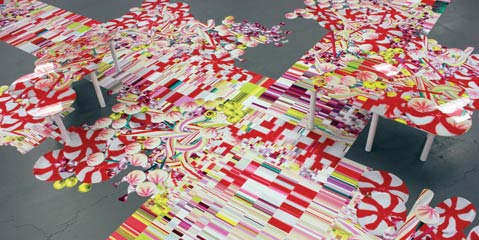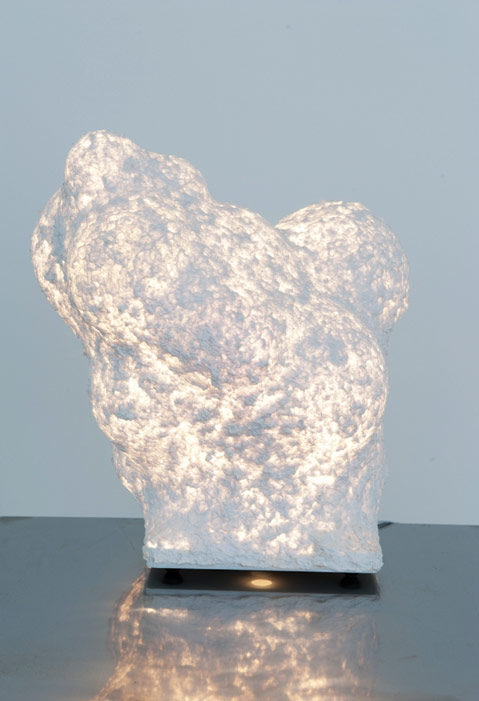Innovative Art by Architects
Almost Anything Goes Casts a Wide Net

Alongside the recent increase in the use of concepts from architecture by non-architects — e.g., “density” and “sustainability”— there’s been a parallel tendency within the profession toward waywardness. Many young people, all well trained by institutions of higher education to “think like architects,” have found that when they encounter the realities of the planning and construction process, they feel restless and discontented with the limited career options imposed by architecture’s traditional business model. When it comes to this new manifestation of the impulse to think like an architect without necessarily designing a building, it is very much the case that, as the title of this new exhibit at MCASB has it, “almost anything goes.”

In Los Angeles, a city that manages to be at once a hub for high-flying architects and their wealthy clients and a wasteland of under-designed urban blight, this “anything goes” spirit has appeared in a variety of ways, six of which are now on view here. The co-organizers of the exhibit, Miki Garcia and Brigitte Kouo, began by looking at a larger group of studios — more than two dozen to start — and gradually narrowed their focus to the six organizations included: Design, Bitches (Catherine Johnson and Rebecca Rudolph); dO|Su Studio Architecture (Doris Sung); Ball-Nogues Studio (Benjamin Ball and Gaston Nogues); Digital Physical/Variate Labs (Miles Kemp); Atelier Manferdini (Elena Manferdini); and Amorphis L.A. (Matthew Au and Ramiro Diaz-Granados). The results of their research now sprawl through the MCA’s second-floor gallery space, and none of it resembles anything one might expect to find in a conventional architect’s studio.
Immediately upon entering, one confronts the elegant and mysterious vortex-shaped fabrications of Doris Sung, a USC professor who works with “thermobimetals,” which are materials that have been selected for their responsiveness to temperature. By designing structures that contract when cold and expand when hot, Sung approximates the organic function of skin in a manufactured object. It’s a grandiose project to be sure — as a species, we’ve been operating with some fairly strong distinctions between structures, clothing, and skin for millennia — but just being around Sung’s beautiful vortices tends to soften that perception almost unconsciously. The complex interlacing of reflecting and nonreflecting parts creates a visual experience in which it’s all but impossible to say what’s inside and what’s outside the figure.
Nearby, and on a similar scale, but in an entirely different idiom, are three “Radiant Body Globs” from 2013 by Ball-Nogues Studio. These biomorphic sculptures were created with the kind of spray gun used to make “cottage cheese” ceilings, and they are lit from within, so they double as large — and rather unlikely — floor lamps. The creepy consistency of the material and the pieces’ cartoonish titles (“Come to Mama,” “Grandpa Lost His Cane”) would seem to ally Ball-Nogues with the subversive strain of Los Angeles abjection art associated with Mike Kelley, but there’s also something light and whimsical about what they are doing that pulls these weirdos back from the edge of insanity.
Design, Bitches dominate the main room with two clever, complementary, and brilliantly executed exercises in 21st-century irony. Across one wall Johnson and Rudolph have re-created a half dozen or so of the best-known photos of great designers — Charles and Ray Eames on the motorcycle, Philip Johnston in his clunky, round, black glasses — but with themselves in place of the original subjects. It’s a great and spunky act of feminist appropriation in the grand tradition of politically motivated beard pulling. Across the room, the duo juxtaposes a floor-mounted set of concrete “clouds” with the hanging specter of the big paper bags they apparently came from. The wires-crossed symbolism of reversing our expectations around what’s heavy and what’s light hits home right away, but then lingers in the mind, as the care with which this meditation on an architect’s primary concerns and media has been “constructed.” This is a fun and memorable piece by a studio to watch, bitches.
The rest of the show ranges widely, from the serene, nearly subliminal impact of the Amorphis installation called “If looks could kill, I am dead now” to the amazing 3-D virtual-reality version of Le Corbusier’s Villa Savoye by Miles Kemp of Variate Labs. Elena Manferdini’s glossy benches are among the show’s more subtle touches, yet they too express a subversive intent beneath their smooth exteriors. Finally, there’s Santa Barbara resident Zack Paul’s juicy installation in the Bloom Projects space, which is not a part of the Almost Anything Goes exhibit, but that works perfectly along with it, meditating as it does on the pattern language of roofs and the special characteristics of materials, in this case brightly colored sandpaper.



